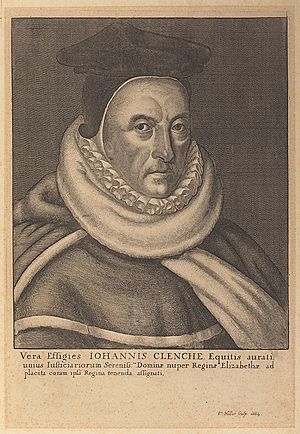John Clench facts for kids
John Clench (born around 1535, died 1607) was an important English judge during the time of Queen Elizabeth I. He was a Serjeant-at-Law, a Baron of the Exchequer, and a Justice of the Queen's Bench. He helped his family settle in Suffolk, near Ipswich. For many years, he also served as the Town Recorder for Ipswich.
Contents
John Clench's Life and Career
Early Life and Education
John Clench was born in Wethersfield, Essex. His father was also named John Clench, and his mother was Joan Amias. He started studying law at Lincoln's Inn in London in 1556. This was a famous place for training lawyers.
When he was younger, John Clench worked for Henry Crane. Mr. Crane was so happy with John's work that he gave him a good deal on renting land in Crowfield, Suffolk. John lived there with his wife, Katheryn Almott. They had thirteen children together!
Becoming a Judge
John Clench became a lawyer in 1568. He quickly became a respected member of Lincoln's Inn. In 1574, he was chosen as the Recorder for Ipswich. This meant he was the town's legal advisor.
He continued to rise in his career. In 1580, he became a Serjeant-at-Law, a senior type of lawyer. The next year, he became a Baron of the Exchequer, a judge who dealt with money matters for the government. Then, in 1584, he became a Justice of the Queen's Bench. This was a very high position in the legal system.
Life in Holbrook
In 1585, John Clench bought a large estate in Great Bealings, near Woodbridge. Later, in the late 1580s, he developed another estate in Holbrook, Suffolk. He bought land from the town of Ipswich to make his Holbrook estate bigger.
In 1589, he bought the manor of Holbrook. After this, Judge Clench lived at Holbrook. It is believed that Holbrook Park, a beautiful garden area, was created around his home there. His eldest son, Thomas, later inherited this estate.
Later Years and Retirement
John Clench was one of four judges who helped run the Chancery court for six months after the Lord Chancellor died in 1591. He continued to work as a judge, often traveling to different parts of England. He helped keep peace and order in various regions.
He was known to be a favorite of Queen Elizabeth I. Even when another judge upset the Queen, she was careful to only blame that judge, not Clench. In 1598, he was involved in managing gifts and money left by a kind person in Ipswich.
By 1600, because of his age and health, he was allowed to stop attending court every day. Three years later, he officially retired with a pension.
Death and Memorial
John Clench passed away on August 19, 1607, at his home in Holbrook, Suffolk. He was buried in Holbrook Church. There is a large monument there to remember him. It shows life-sized statues of him and his wife, Katheryn.
The monument shows Judge Clench in his judge's robes. His wife, Katheryn, is also shown, wearing a fancy dress of the time. Below them, there are smaller figures representing their children. This monument helps us remember an important judge from England's past.
Family
John Clench and his wife, Katheryn Almott, had five sons and eight daughters.
- His oldest son, Thomas Clench (around 1557-1624), inherited the Holbrook estate. Thomas was a Member of Parliament and served as sheriff of Suffolk.
- His second son, John Clench, lived in Bealings. He and his wife, Joan, have a monument in Great Bealings church.
- Other children included Robert, Margery, Joanne, Lore, Katherin, Elizabeth, Anne, Presila, and Thomasin.


